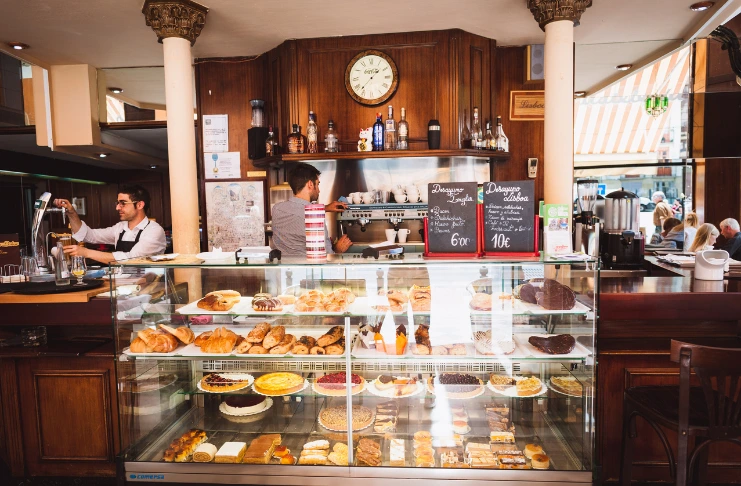
Bakery businesses are attracting new entrants faster than most segments in foodservice. With lower entry barriers than full-service restaurants and strong year-round demand for baked goods, the category looks appealing. However, the economics are more complex than they appear.
Unlike QSRs or cafés, bakeries face high upfront costs in commercial equipment and perishables. Plus, the operating expenses, such as utilities, labor, and inventory, scale quickly and require close monitoring.
Many first-time owners under-budget for setup and overextend during the early months, leading to cash flow pressure just as the business starts gaining traction.
Even experienced restaurateurs entering the bakery space often misjudge cost drivers like ingredient spoilage, daily prep labor, and the energy intensity of ovens and refrigeration. These hidden inefficiencies can affect profitability despite strong sales.
This blog covers the major bakery setup costs, from the one-time investments to recurring monthly expenses across different bakery models, to help you get started.
Startup Investment at a Glance: What You Need to Know
Opening a bakery can be an attractive entry point into the food business. It allows for operational flexibility, smaller footprints, and focused production models, making it appealing to both independent entrepreneurs and multi-unit operators. However, the cost to launch varies significantly based on format and market.
Bakery startup costs can range widely, from around $15,000- $25,000 for a small home-based bakery or online bakery to over $70,000 for a full-service bakery café with dine-in. The costs can go even higher for commercial bakeries, reaching over $100,000+, depending on the buildout and scale.
The cost of a bakery business can differ significantly, depending on multiple factors including-
1. Type of Operation
Retail bakeries with display counters have different capital needs than production-focused wholesale kitchens. Dine-in bakery cafés require more square footage, HVAC zoning, seating infrastructure, and often an expanded menu, all of which drive up investment.
2. Menu Complexity
A limited menu, like one featuring only artisan bread or cookies, keeps both equipment and staffing requirements manageable. In contrast, menus with extensive pastry, cake, and gluten-free item ranges require specialized tools and trained labor, increasing capital needs.
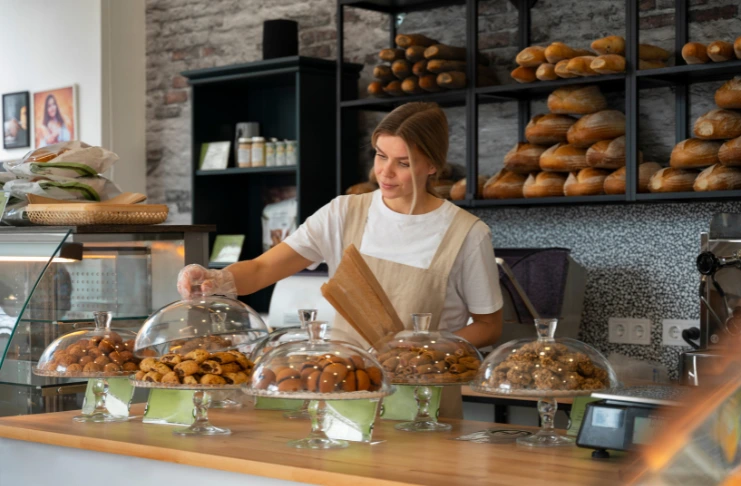
3. Equipment
Commercial bakeries rely on high-capacity, specialized equipment such as convection ovens, planetary mixers, proofers, walk-in refrigerators, and dough sheeters. These units represent a significant share of upfront investment and directly impact production capacity, product consistency, and labor efficiency. As a result, choosing between new, leased, or refurbished equipment can make a substantial difference to upfront costs.
4. Location and Space
High-footfall urban locations cost more per square foot and often require premium finishes to meet brand standards. In addition, if you end up renting or leasing an older building, it may also need expensive retrofits for ventilation, grease traps, or three-phase power to support bakery-grade appliances.
These renovations can substantially raise your per-square-foot buildout cost, especially in cities with strict regulations.
5. Compliance
Beyond licensing and incorporation, bakeries must comply with multiple regulations. Regulatory requirements such as zoning restrictions, ADA accessibility requirements, health department codes, and fire safety standards can vary from state to state.
At the same time, it’s not uncommon for initial permits to be delayed or rejected, which means costly adjustments and re-inspections may be required. So, planning ahead for both time and budget flexibility is essential to avoid launch delays and unexpected spending.
INDUSTRY INSIGHT
Between 2018 and 2022, U.S. retail sales of baked goods grew at a CAGR of 5.9%. In fact, the U.S. baking industry generates around $533 billion in economic output, accounting for approximately 2% of GDP, and supports over 2.18 million jobs.
Choosing the Right Bakery Format: Cost Implications
The bakery format you choose defines your startup costs, staffing model, kitchen requirements, and path to profitability. A retail bakery with no seating operates on a very different cost structure from a production-focused facility or a café with an extensive menu.
Before estimating your capital needs, it’s essential to understand how each format impacts where and how much you’ll need to invest.
A. Counter‑Only Retail Bakery
This model prioritizes takeaway and speed with large display units and quick-service flow. Most of the startup capital goes into high-output ovens, cooling displays, prep stations, and a branded layout to optimize foot traffic.
Average startup investment for this format ranges between $30,000 and $60,000, depending on location and inventory requirements. A retail bakery has moderate staffing requirements, which lowers the labor costs, but consistent product turnover is important for profitability.
B. Bakery Café with Seating
Adding dine-in space introduces significant capital demands to your retail bakery setup, such as tables and seating, ADA-compliant design, beverage station (coffee/espresso), extended HVAC, and décor.
This means you’re launching both front- and back-of-house operations. As a result, startup costs can fall between $60,000 and $75,000+, with longer timelines due to higher staffing needs and operational training.
C. Wholesale Bakery
Since they are focused purely on volume, wholesale kitchens minimize front-of-house expenses. You need to invest heavily in industrial-capacity ovens, storage, and packaging infrastructure. In addition, a compliant workspace, proper labeling systems, and distribution logistics are essential.
This brings the investments for mid-tier production setups around $71,000 to $100,000+, depending on automation and volume targets.
D. Mobile Bakery
Mobile bakeries, such as trailers, carts, or pop-up kiosks, offer a lower-cost entry point by eliminating rent and minimizing space requirements. However, it still involves key expenses for space and equipment like compact ovens, ventilation, and custom equipment fitting.
Moreover, if you use a shared kitchen or outsource production, the startup cost can be up $60,000 upfront.
E. Ghost Kitchen or Online Bakery
Operating from a delivery-focused kitchen without customer-facing areas offers a middle path between retail and wholesale. With no seating or display, you invest in efficient baking and packaging workflows.
Setup costs for an online bakery fall in the $25,000 to $30,000 range, largely due to kitchen retrofits and tech integrations.
Bakery Setup Costs: Initial Investments to Consider
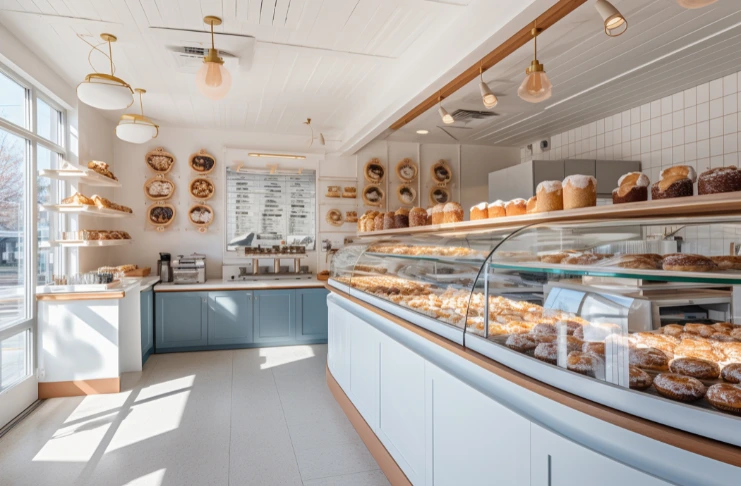
1. Location and Buildout
Most bakery operators begin by leasing a retail or industrial space, typically 1,000 to 1,500 sq ft. For this, rent can range between $900 and $6,000/month, depending on the city and neighborhood.
Plus, choosing a bakery space also includes upfront costs such as security deposit and first month’s rent, which is commonly three times the monthly rent (e.g. $6K for a $2K/month space).
Further, bakery owners must account for the buildout expenses, which depend on existing infrastructure. Renovations may cost $20,000 to $50,000, while full kitchen buildouts, including plumbing, electrical upgrades, ventilation, and flooring, can climb to $100,000 or more. Buildout average costs vary from $100 to $300+/sq ft., depending on whether front‑of‑house or back‑of‑house functionality is required.
You’ll also have to incur approval and inspection fees for the space, including zoning permits, health department reviews, ADA compliance adjustments, fire safety inspections, and signage permits.
These regulatory costs typically run between $500 and $4,500+, depending on location and the number of required re‑inspections.
2. Bakery Equipment Costs: Kitchen and Service Essentials
Baking businesses require specialized, high-capacity equipment. Most standard bakery setups budget between $20,000 and $30,000 for basic kitchen machinery and baking supplies, while larger commercial bakeries can spend double that or more.
- Convection or deck ovens range from $400 to $15,000+, depending on capacity and features.
- Planetary or spiral mixers typically cost $500 to $2,000, with professional-grade industrial units commanding higher prices.
- Proofing cabinets, walk-in refrigeration, dough sheeters, and packaging stations can add another $4,500 to $10,000+ to the budget, depending on size, automation level, and brand.
- If you’re customer-facing, display chillers and branded service counters will cost up to $1,000–$5,000+, depending on design complexity.
- Beyond the baking equipment, service essentials like cooling racks, mixing bowls, spatulas, and dine-in/packaging supplies can cost $1,000-$3,000+ initially.
Choosing between new, leased, or refurbished equipment can significantly shift upfront costs. While refurbished or leased equipment reduces initial expense and preserves working capital, it may carry more maintenance risk.
Similarly, new equipment comes with warranty protections and uptime assurance but requires a higher initial payment.
3. Interior Setup
Retail and dine-in models need a well-planned interior to ensure a seamless customer experience. For this, owners can expect to spend around $10,000 to $70,000 on interior setup, including seating, décor, lighting, signage, fixtures, and customer flow design.
Here, key investments include durable and comfortable seating, ADA-compliant pathways, menu boards or chalkboards, branded signage, and aesthetically pleasing lighting.
Your setup should align with brand positioning while keeping flow efficient, reducing customer wait times, and optimizing labor.
Moreover, while effective design enhances perceived value and can justify a higher ticket price, avoid overspending here, as it can quickly impact your costs and ROI.
4. Licensing, Legal, and Compliance Costs
Before opening doors, you must secure proper business and foodservice permits:
- Business registration and entity setup (such as LLC), including EIN
- Food service license and health department inspection fees
- Fire department clearance, building use permits, signage permits, and occasional re‑inspection or correction fees
Total licensing and legal costs typically fall between $500 and $3,500+, depending on jurisdiction and complexity of required modifications.
Further, accessibility modifications, such as ramps, ADA-compliant restrooms, wide doorways, and signage, will add to costs, especially if you’re opening a dine-in bakery. Factoring these elements early avoids disruptions during final inspections and potential fines.
Finally, it is essential to schedule and complete inspections early on, with buffer time and contingency funding to accommodate potential delays or additional compliance adjustments.
5. Opening Inventory
Your initial inventory covers more than just ingredients; it also includes packaging, labels, smallwares, and consumables.
- Your initial inventory expenses can range between $1,000 and $5,000, depending on menu offerings and order volume.
- Packaging supplies such as bakery boxes, liners, pastry bags, labels, and branded material can add $2,000 to $5,000, particularly for premium or custom packaging options.
To make the most of your inventory and optimize costs, it is essential to forecast demand accurately. This is because perishables like eggs, dairy, and fresh fruit spoil quickly, so your orders need to match your expected sales.
Ideally, it’s smart to build in a 10-15% buffer above projected usage during your first few weeks. This helps prevent shortages without overspending on excess stock.
Operating Costs for Bakery
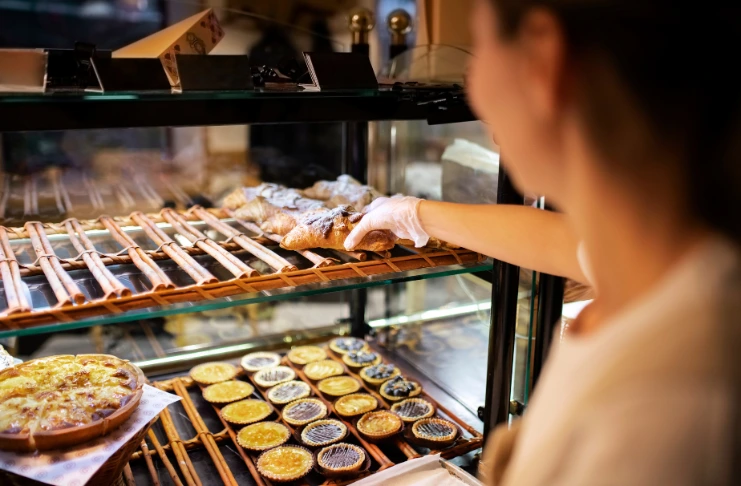
Once your bakery is open, managing recurring expenses becomes critical for cash flow and profitability. Here’s how to plan effectively across four major cost categories:
1. Labor and Payroll
Labor is often your largest recurring cost. Most bakeries hire at least one lead baker, a prep assistant, and front-of-house staff if operating a retail counter. Within this, the average hourly wage for a baker is around $18, while that for cashiers or counter attendants is around $14 per hour, depending on location.
For a small to mid-sized bakery with 3-4 employees, total payroll can reach $5,000-$20,000 per month. This includes wages, payroll taxes, workers’ comp, and employer-side benefits. Moreover, even if you operate with seasonal or part-time staff, you’ll also need to account for training hours and turnover.
2. Utilities and Maintenance
Running commercial ovens, walk-in refrigerators, mixers, and HVAC units drives up utility bills. Expect to spend $500 to $3,000 per month on electricity, gas, water, and internet for a standard bakery setup.
You’ll also need to budget for cleaning contracts, waste removal, pest control, and equipment servicing. These services typically add another $400 to $600 per month, depending on the space and local requirements. Scheduling preventive maintenance can help avoid costly repairs and minimize downtime.
3. Inventory
Your inventory costs will depend on what you bake and how often you restock. A typical bakery spends between $4,000 and $12,000 per month on ingredients like flour, dairy, eggs, yeast, chocolate, and seasonal items.
Since many ingredients are perishable, consider planning for weekly ordering to avoid going understocked. You’ll need to forecast demand carefully; overordering leads to spoilage, and underordering can mean missed sales. Waste is unavoidable, but tracking batch-level usage and adjusting purchase quantities regularly can reduce losses.
4. Software Tools
Digital tools are essential for keeping bakery operations accurate and efficient. A reliable tech stack typically includes a POS system, payroll and time tracking, inventory management, and recipe costing software. Together, these can cost between $200 and $600 per month, depending on your setup and scale.
Instead of managing these systems separately, many bakeries use integrated platforms that centralize all functions in one place. This reduces duplicate entries, prevents costly errors, and frees up time for higher-value work like production planning or customer engagement.
The result? Smarter scheduling, tighter inventory control, fewer order issues, and easier financial reporting, which help protect margins in a competitive business like this.
Additional Costs That Can Strain Your Budget
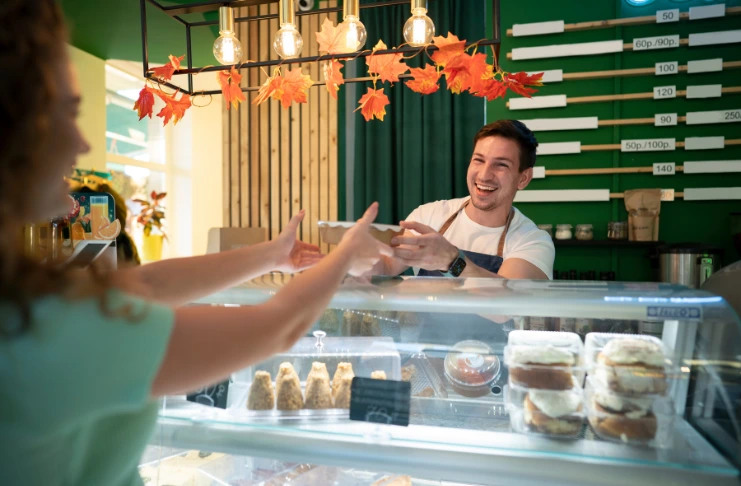
Even the most carefully planned bakery launch can run over budget, often because non-obvious costs get missed in early estimates. Below are six frequently overlooked items that should be factored into your startup budget:
1. Staff Training and Onboarding Time
Training new hires, from bakers and prep staff to front-of-house staff, takes paid hours before revenue-generating work begins. You can expect several weeks of shadow shifts and supervision, where the burn time can amount to $2,000-$5,000, depending on staff size and local wage rates.
2. Equipment Installation
Heavy ovens, walk-in fridges, proofers, and prep stations often require specialized installation, including plumbing or gas hook-ups, electrical wiring, and calibrations. These installation and associated service charges can escalate to $5,000-$15,000, particularly if adjustments are needed post-inspection, or if facility modifications are required.
3. Credit Card Processing Fees
Credit-card processing fees typically average 2.5% to 3.5% per transaction. In most bake shops, transaction fees accumulate to thousands each month, eating into margins unless built into pricing strategies. Platforms with fixed monthly fees or merchant accounts can reduce per-transaction costs, especially as volume increases.
4. Photography, Website, and Menu Design
Professional food photography, branded menu board design, and website creation are essential marketing tools. Even a basic bakery website costs $1,000-$3,000, while full-service options may reach $3,000-$10,000 or more, depending on features (IIHGlobal). DIY solutions reduce cost but trade off polish and brand impact.
5. Unexpected Downtime Due to Equipment or Permits
Broken equipment or inspection issues can delay opening for days or weeks. Without alternate ovens or backup systems, lost sales and rescheduling logistics may cost $3,000-$10,000 in short-term revenue and added labor.
6. Reinspection Due to Compliance Failures
If local authorities flag health or ADA noncompliance, fix costs and reinspection fees can quickly accumulate, typically $500-$2,000,+ depending on corrective work needed and number of follow-up inspections.
Conclusion
Setting up a bakery is as much a financial decision as it is a strategic one, but cost alone doesn’t define success. What often separates thriving bakeries from struggling ones isn’t always the upfront investment, but how well the investment is aligned with the business model, location, and long-term plans.
It is a good idea to plan for scalability, right from the start, by optimizing your layout and equipment choices early on. If you’re focusing on artisanal bakery items or niche markets, think about whether your pricing and process can support that sustainably. And if you’re starting small, your offerings don’t have to be limited.
Many successful bakeries begin with narrow menus and grow through consistency and customer trust. The clearer you are on what kind of bakery you want to run, the easier it becomes to plan investment, avoid over budgeting, and grow.
Frequently Asked Questions
The cost of starting a bakery typically ranges between $15,000 and $75,000 or higher in the case of a commercial bakery. This covers key expenses like kitchen equipment, space buildout, initial inventory, and permits. The total depends heavily on the size, location, and format of the bakery.
On average, U.S. bakeries deliver net profit margins around 5-15%. Effective cost control with smart labor and waste management is critical to maintaining margins.
To set up a small bakery, start with a compact space and focus on a simple, high-margin menu. You also need to lease or buy refurbished equipment, apply for licensing, and hire a team to get the operations going.
Monthly rent for a bakery varies widely based on location. A 1,500 sq ft bakery may require rent ranging from $2,500 to $6,000, plus a security deposit of 1-3 months’ rent.
Startup costs for a bakery can be anywhere from $15,000 to $1,00,000+, depending on format, location, equipment level, and menu complexity.
You can start small with a cloud or home bakery with an investment of as little as $15,000 to $50,000, depending on equipment and regulatory requirements.
The average cost to open a bakery ranges from $15,000 to $75,000+ based on the format, location, and size of operations.
To start a low-budget bakery, consider an online or home bakery setup with a limited menu and second-hand equipment. You can also hire part-time staff and begin with delivery or catering to minimize upfront rent and buildout costs.
On average, you need $15,000-$75,000 to open a small-to-mid-size bakery, including space prep, equipment, licensing, initial inventory, and opening marketing.
Yes, bakeries can be profitable with net margins often ranging between 5% and 15%. When you manage costs carefully, it’s possible to run a lean operation and earn up to 15% of sales as owner income.








